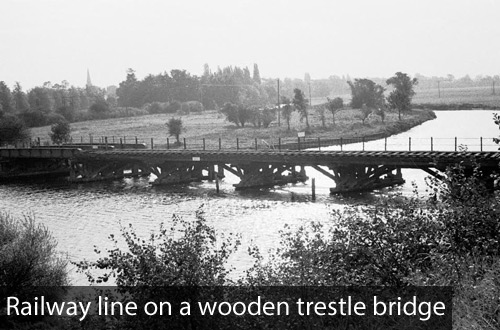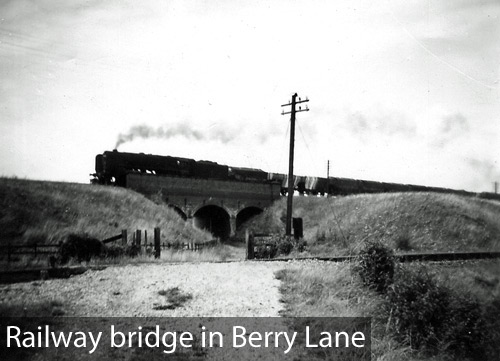The Steam Era did not pass Godmanchester by.
The Railway serving Godmanchester was the GN/GER Joint Line, the Kettering, Thrapston, Huntingdon branch. The line came in from Buckden. It dived under the main GNR line, near West Meadow, at the end of Berry Lane. It crossed the Ouse, and then entered Huntingdon, from the South. Then, it crossed the river again, near Castle Hill and the Bridge Hotel, over a wooden trestle bridge. Alas, this was demolished in 1970 (the writer has photos of this). There was a level crossing over Ermine Street. The crossing keeper's house remains still. The line passed the Hosiery (Riverside) Mill, and the flour mill, to Godmanchester station, going on to St. Ives, and Cambridge.
Lane. It crossed the Ouse, and then entered Huntingdon, from the South. Then, it crossed the river again, near Castle Hill and the Bridge Hotel, over a wooden trestle bridge. Alas, this was demolished in 1970 (the writer has photos of this). There was a level crossing over Ermine Street. The crossing keeper's house remains still. The line passed the Hosiery (Riverside) Mill, and the flour mill, to Godmanchester station, going on to St. Ives, and Cambridge.
Owing to the trestle bridges, nothing heavier than an 0-6-0 Locomotive, 40 Tons, or a Johnson 2-4-0 or a GER T19 2-4-0 were allowed East of Huntingdon.
The line shut in September, 1959.
A well-known firm of Traction Engine builders was Fowell & Co. Ltd of Cromwell Works St. Ives starting in 1878. Joseph Fowell and Joseph Jun. and a nucleus of skilled men had been at Burrells of Thetford. The firm finished in 1976, and had built 109 engines. A son, George Fowell moved to Huntingdon, where he became manager to B. Bayliss & Thackray at the Victoria Foundry. This was in the Ferrars Road area, near Rosecrea Avenue, and Spandard Products (Silent Channel). In 1899, this was bought out by Harvey and Williams. They had access to patterns, drawings, and parts of engines. Two Harvey and Williams' Traction Engines, nos. 88 and 89 were built at Huntingdon in 1899. They had been partially built at St. Ives.
George's son Alfred, after a quarrel left St. Ives, went also to the Victoria Foundry and subsequently had a small engineering business in Godmanchester. This was in Clyde Yard, Cambridge Street, where TRANSART used to be. He died in 1947 at Euston Street, Huntingdon.
Frasers' had the large Great Northern Sawmills at Hinchingbrooke (where the large school used to be) till 1936. It was powered by an enormous Barrows & Stewart Portable.
In 1936, the mill was acquired by Pepper's Mill, near the Iron Bridge. They made Bobbins for Trawlers. They ran an Aveling and Porter Steam Tractor, and a Foster 5 Ton Tractor. This was driven by one Billy Wells.
He lived at Orchard Lane, near Peacocks. The mill later moved to Stukeley Road.
Another well-known firm using steam was Marshall's Huntingdon Brewery.
Their premises were in High Street, now Chequers Court. They ran two Foden 5 Ton steam wagons. Marshalls bought out the firm of Jenkins and Jon

es, nearby. They ran a Sentinal steam wagon. 'Taylor, the engine man' was a threshing contractor. His yard was behind the Black Bull. Mrs. Elizabeth Taylor in 1907 obtained a 7 HP Northampton-built Allchin, no. 1292
. Jonah Barringer of London Street ran a Mann Steam Cart, a type of wagon, in the early 1920's. Manns works were at Hunslet, Leeds.
'Buster" Ashley farmed in Silver Street, Godmanchester. These people had a /HP Clayton & Shuttleworth single cylinder traction engine. The writer has a photo of this engine, belted up to a threshing machine. James Thompson of Buckden had a sawmill in School Lane, this was driven by a Barrows & Carmichael portable. (They were built at Banbury). Huntingdonshire County Council ran two Aveling-Porter steam rollers. They were based at Spaldwick. One was driven by Bill Manning of Pipers Lane, Godmanchester. There is a point half was along the Causeway, where engines used to lift water. This point was an attempt to "filter' water. Feed water for an engine, contaminated by ducks, caused priming - (water being lifted by the Steam to the cylinder) - and causing much trouble.
Regrettably, this is a vanished era. The only evidence we have now, are the occasional gatherings of local traction engines, at Wood Green, the Black Bull or Brampton.
Dr J.L.Middlemiss.